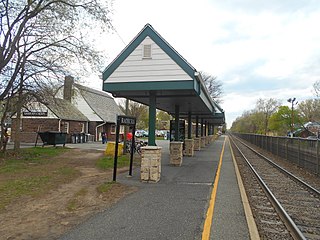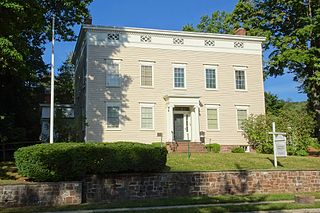
The Passaic River is a river, approximately 80 mi (129 km) long, in northern New Jersey in the United States. The river in its upper course flows in a highly circuitous route, meandering through the swamp lowlands between the ridge hills of rural and suburban northern New Jersey, called the Great Swamp, draining much of the northern portion of the state through its tributaries. In its lower portion, it flows through the most urbanized and industrialized areas of the state, including along downtown Newark. The lower river suffered from severe pollution and industrial abandonment in the 20th century. In April 2014, the U.S. Environmental Protection Agency (EPA) announced a $1.7 billion plan to remove 4.3 million cubic yards of toxic mud from the bottom of lower eight miles (13 km) of the river. It is considered one of the most polluted stretches of water in the nation and the project one of the largest clean-ups ever undertaken.
Improvements to the steam engine were some of the most important technologies of the Industrial Revolution, although steam did not replace water power in importance in Britain until after the Industrial Revolution. From Englishman Thomas Newcomen's atmospheric engine, of 1712, through major developments by Scottish inventor and mechanical engineer James Watt, the steam engine began to be used in many industrial settings, not just in mining, where the first engines had been used to pump water from deep workings. Early mills had run successfully with water power, but by using a steam engine a factory could be located anywhere, not just close to a water source. Water power varied with the seasons and was not always available.

Newark Broad Street is a NJ Transit commuter rail and light rail station at 25 University Avenue in Newark in Essex County, New Jersey, United States. Built in 1903, the station's historic architecture includes an elegant clock tower and a brick and stone façade on the station's main building.

A Corliss steam engine is a steam engine, fitted with rotary valves and with variable valve timing patented in 1849, invented by and named after the American engineer George Henry Corliss of Providence, Rhode Island.

Orange is a New Jersey Transit station in Orange, Essex County, New Jersey, United States, along the Morris & Essex Lines. Eastbound service is available via the Kearny Connection to Secaucus Junction and Penn Station in Midtown Manhattan and there is also service to Hoboken Terminal.

Mountain Station is a New Jersey Transit station in South Orange, Essex County, New Jersey, United States, along the Morris and Essex. The station, built in 1915, has been listed in the New Jersey Register of Historic Places and National Register of Historic Places since 1984 and is part of the Operating Passenger Railroad Stations Thematic Resource.

The Gateway Region is the primary urbanized area of the northeastern section of New Jersey, United States. It is anchored by Newark, the state's most populous city, and is often also known as the Newark metropolitan area.

Radburn is a New Jersey Transit train station in the Dutch Colonial Revival style, served by the Bergen County Line. It is on Fair Lawn Avenue in the Radburn section of Fair Lawn, in Bergen County, New Jersey, United States. It is one of two New Jersey Transit train stations in Fair Lawn, the other being Broadway.

George Henry Corliss was an American mechanical engineer and inventor, who developed the Corliss steam engine, which was a great improvement over any other stationary steam engine of its time. The Corliss engine is widely considered one of the more notable engineering achievements of the 19th century. It provided a reliable, efficient source of industrial power, enabling the expansion of new factories to areas which did not readily possess reliable or abundant water power. Corliss gained international acclaim for his achievements during the late 19th century and is perhaps best known for the Centennial Engine, which was the centerpiece of the 1876 Centennial Exposition in Philadelphia.

The Clark Thread Company Historic District, located at 900 Passaic Avenue, East Newark, Hudson County, New Jersey, United States, is a large mill complex. Begun in 1875, it was a major manufacturing site of the Clark Thread Company, the world's leading manufacturer of sewing thread, until 1935. The complex was designated a National Historic Landmark District in 1978 for this association. It now functions as an industrial park housing a diversity of businesses.

The Israel Crane House is a federal-style home located at 110 Orange Road in Montclair, Essex County, New Jersey. The house has had a rich history and was added to the National Register of Historic Places on March 14, 1973 for its significance in architecture, conservation, and industry.

Bridge Street Bridge is a swing bridge over the Passaic River connecting Newark and Harrison, New Jersey. It is the 10th bridge from the river's mouth at Newark Bay and is 5.7 miles (9.2 km) upstream from it. Carrying vehicular traffic, the roadway is designated County Route 508.

The Corliss Steam Engine on the Pawnee County Fairgrounds in Pawnee, Oklahoma is a Corliss steam engine that was built c. 1912. It and a twin sister engine were originally built for the Blackwell Zinc Co., of Blackwell, Oklahoma. It powered most of the electricity-powered machinery in the 1000-employee zinc smelter plant until the plant closed in 1973.

St. Mary's Abbey Church is a historic Roman Catholic parish church located within the Archdiocese of Newark at 520 Martin Luther King Blvd and William St. in Newark, Essex County, New Jersey, United States.

Riverbank Park is a park in the Ironbound section of Newark, Essex County, New Jersey, United States. The park was opened in 1910 and was added to the National Register of Historic Places on April 16, 1998. It is the smallest and one of the most heavily used parks in the Essex County Park System.

Dock Bridge is a pair of vertical lift bridges crossing the Passaic River at Newark, Essex County and Harrison, Hudson County, New Jersey, United States, used exclusively for railroad traffic. It is the seventh crossing from the river's mouth at Newark Bay and is 5.0 miles (8.0 km) upstream from it. Also known as the Amtrak Dock Vertical Lift, it carries Amtrak, NJ Transit, and PATH trains. It is listed on the state and federal registers of historic places.

The old Essex County Jail is located in the University Heights section of Newark, Essex County, New Jersey, United States. The jail is Essex County's oldest public building and a national landmark of value for its architectural and social history. The complex consists of about 20 structures of various size, age, and function ranging in date from the 1830s to 1930s. Collectively, they represent the evolution of American prison history over 100 years. For the quality of its architecture, its social history, and its links to the 1967 Newark Riots, this jail was added to the National Register of Historic Places on September 3, 1991.

The Jackson Street Bridge is a bridge on the Passaic River between Newark and Harrison, New Jersey. The swing bridge is the 6th bridge from the river's mouth at Newark Bay and is 4.6 miles (7.4 km) upstream from it. Opened in 1903 and substantially rehabilitated in 1991 it is listed on the New Jersey Register of Historic Places (ID#1274) and is eligible for the National Register of Historic Places. The bridge was re-lamped in 2012.

The Clay Street Bridge is a bridge on the Passaic River between Newark and East Newark, New Jersey. The swing bridge is the 13th bridge from the river's mouth at Newark Bay and is 6.1 miles (9.8 km) upstream from it. Opened in 1903, the Warren through truss rim-bearing bridge was substantially rehabilitated in 1975–1976, its original working parts are now part of the collection of the Newark Museum. It is listed on the New Jersey Register of Historic Places (ID#5153) and is eligible for the National Register of Historic Places.

The machine industry or machinery industry is a subsector of the industry, that produces and maintains machines for consumers, the industry, and most other companies in the economy.























